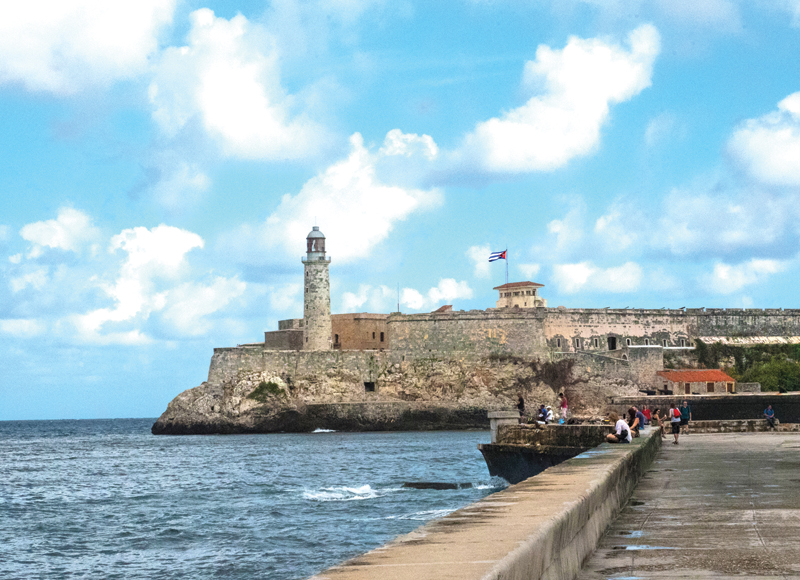Revisiting Cuba After 60 Years
by
Armando Chacon
During the Cold War between the two superpowers, Fidel Castro seized power of the Cuban government in 1959. Although he promised to improve the standard of living for the Cuban people, this came at the expense of thousands of doctors, engineers, and other professionals who eventually fled to the United States, causing an economic “brain drain.” Productivity decreased and the country’s financial reserves were drained within two years.
During the next several years, all private enterprises in Cuba were taken over by Castro’s revolutionary government, including my father’s business. There was no compensation, no future, no freedom. That is when my father decided to emigrate to the United States. After all of the required paperwork was processed, it was time for our family to leave the place of our birth and the United States welcomed us with open arms. The year was 1967.
The flight from Miami to Havana was pretty quick, and we soon landed at Jose Marti Airport. The view from the plane window was very emotional, seeing the palm trees and the landscape that I had not seen since I was 13 years-old. It was a bittersweet moment. Lots of memories were going through my mind… childhood memories. A taxi was prearranged by our host at the Airbnb that I had rented for our stay at the old city.
Our Airbnb was not far from the airport, but driving there was like stepping back in time. From my memories of my childhood, not much had changed. Interestingly enough, the name of the Airbnb we had chosen was “El Balcon de Chacon” and was located on Chacon Street. Although I’m unaware of any connection to my family, I thought the name was cute. Also, one of our favorite restaurants there was named “Chacon 162” and it was a Paladar, which was a privately-owned food establishment, something that has only recently been allowed by the Cuban government.
After being greeted by our host and making ourselves comfortable, we decided to explore the old city and rented a horse and carriage to take us around and see where things were located. Later, we would explore the city by ourselves. Although the carriage driver did not speak English, his partner spoke perfect English and described places to my wife as we drove around.
The carriage ride lasted less than an hour. Afterwards, my wife and I decided to have lunch at Chacon 162. The meal, which came out to about $25, consisted of lobster for her and Ropa Vieja (shredded beef) with rice for me and, of course, Mojitos. Keep in mind that the average Cuban makes about $20 to $30 a month.
We then started to walk around and see some of the sights; the Cathedral was around the corner so we decided to go there first. There were a few people there posing for tourists, trying to make a few bucks, dressed in old Spanish colonial clothing. I paid $5 to do a picture with them, but it was worth it. The lady planted a big kiss on my cheek and, without knowing it, I walked around with a big lipstick kiss on my face. My wife did not tell me about it until after she had taken a bunch of pictures of me.
We walked awhile and later rode again in a different horse carriage. By the way, it’s OK to bargain with them about prices, which goes to the government. But, I also tipped them well because that money goes to them personally.
For car aficionados, standing on a street corner is like being in a candy store, especially by the Capitol Building. You can pay to ride in one for an hour… Chevrolets, Fords, Buicks, Mercedes, Pontiacs… primarily from the 1940s and the 1950s.
There are several pictures included in this article that show the beauty of Cuba, and that was my intention. As I was taking pictures and working on those images, I captured the real Cuba and the ones that some ignore.
“Museo de Bellas Artes” (The Museum of Fine Arts) Wow! I was floored when I walked into this building. The more we looked, the more we appreciated the beautiful architecture… the columns, the arches, the stained-glass ceiling, etc.
That’s when I noticed the sunlight coming in from a hole in the stained glass ceiling. What happened up there? We were told that since the last hurricane, this portion of the stained glass broke, and it has not been repaired. That took place many months ago.
The old city of Havana, like much of Cuba, has beautiful buildings everywhere. Some have been renovated, or at least kept from crumbling, but it is a shame to see so many buildings in disrepair or simply waiting to crumble, sometimes injuring or killing the occupants inside.
The images seen here have been manipulated with Adobe Photoshop, Topaz filters, and a mixture of other plug-ins. Sometimes I write down what I use, sometimes I just turn up the music and lose myself in the creative portion of our wonderful profession.
Revisiting one’s past, especially after six decades, can be an enlightening yet moving experience. Having to leave one’s homeland under such circumstances, as did my family in 1967, can be devastating and difficult to forget. While I have strong feelings about Castro and what he has done to Cuba, I am also grateful to the United States for accepting us with open arms. Although we cannot forget the past, we must also be grateful for what we have, especially when we consider the living conditions of people in other countries who struggle just to feed their families.
